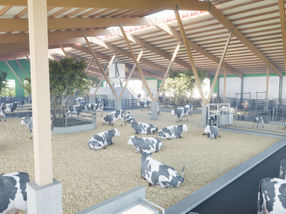Campus Vienna Biocenter - Development of a Quick Detection Method for Complex Immune Analytes
Anzeigen
An analysis method permitting the simultaneous quantification of numerous parameters in the immune system was recently presented at the Campus Vienna Biocenter. The technology, which has been developed by Bender MedSystems, is based upon the principle of a widespread analysis device and thus allows for rapid implementation in daily laboratory life. It thus succeeds in satisfying the growing demand at clinical and pharmaceutical organisations for increasingly efficient analysis methods at favourable costs.
The simultaneous determination of a high amount of different parameters in body fluids currently represents an important challenge in diagnosis. Located at the Campus Vienna Biocenter, Bender MedSystems GmbH now meets this challenge with an efficient solution in the form of FlowCytomix technology, which permits simultaneous detection of up to ten analytes with a technology implemented in everyday laboratory life: the automatic sorting of fluorescence labelled cells. Individual cells are detected and differentiated on the basis of their size and fluorescence intensity by means of this technology, which is known as Flow Cytometry.
This new FlowCytomix product does not measure cells, however: it assesses the synthetic, fluorescent microspheres that have been coated with specific antibodies and added to the sample. These bind substances in body fluids, which can then be identified. Each of the maximum ten types of microspheres only carries antibodies for a single specific substance. After the separation of microspheres, the bound antibodies can be detected via a specific antibody or two-step reaction. The automatic analysis of the substance size and the dye intensity thus allow for the identification and quantification of the bound substance.
The intensive research environment at the Campus Vienna Biocenter offered significant support in the development of this detection method by Bender MedSystems. Close contact with researchers from academic and commercial research institutions has already allowed this technology to be ideally optimised for routine applications during its development, and the result as been a reduction in analysis time and work expenditure as well as lower sample amounts. The detection sensitivity and results are comparable with classic ELISAs, while the dynamic measuring scope was actually extended considerably.
Weitere News aus dem Ressort Wissenschaft
Meistgelesene News
Weitere News von unseren anderen Portalen
Verwandte Inhalte finden Sie in den Themenwelten
Themenwelt Antikörper
Antikörper sind spezialisierte Moleküle unseres Immunsystems, die gezielt Krankheitserreger oder körperfremde Substanzen erkennen und neutralisieren können. Die Antikörperforschung in Biotech und Pharma hat dieses natürliche Abwehrpotenzial erkannt und arbeitet intensiv daran, es therapeutisch nutzbar zu machen. Von monoklonalen Antikörpern, die gegen Krebs oder Autoimmunerkrankungen eingesetzt werden, bis hin zu Antikörper-Drug-Konjugaten, die Medikamente gezielt zu Krankheitszellen transportieren – die Möglichkeiten sind enorm.

Themenwelt Antikörper
Antikörper sind spezialisierte Moleküle unseres Immunsystems, die gezielt Krankheitserreger oder körperfremde Substanzen erkennen und neutralisieren können. Die Antikörperforschung in Biotech und Pharma hat dieses natürliche Abwehrpotenzial erkannt und arbeitet intensiv daran, es therapeutisch nutzbar zu machen. Von monoklonalen Antikörpern, die gegen Krebs oder Autoimmunerkrankungen eingesetzt werden, bis hin zu Antikörper-Drug-Konjugaten, die Medikamente gezielt zu Krankheitszellen transportieren – die Möglichkeiten sind enorm.
























































